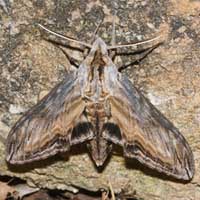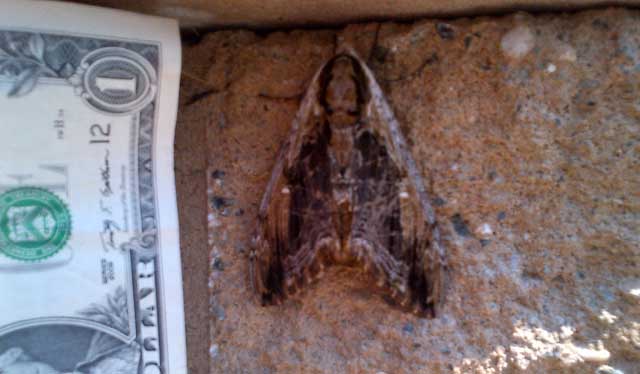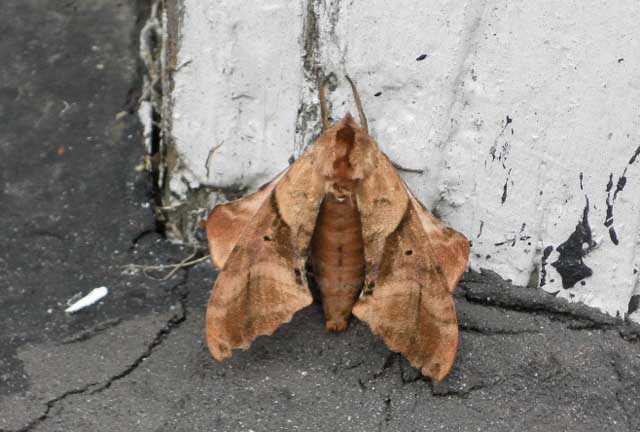Sphinginae subfamily
Sphingini tribe:
 |
Ceratomia amyntor
WO/JF,
the Elm Sphinx or Four-horned Sphinx
The upperside of the forewing is brown with dark brown and white
markings including a white costal area near the wing base, dark
streaks along the veins, and a white spot in the cell.
Larvae feed on Elm (Ulmus), birch (Betula), basswood (Tilia), and
cherry (Prunus). |
Ceratomia amyntor, Budd Lake, July 19, 2012, John Foley.
 |
The upperside of the forewing is yellowish brown with
no white markings, but there are indistinct black lines and dashes.
The larvae feed in large groups and are much more
spectacular than the moths. Catalpa is the larval host. |
 |
The upperside of the forewing is pale brownish gray with wavy black
and white lines and a black-outlined white cell spot.
|
 |
The upperside of the forewing is dark brown with a dusting of white
scales. Some moths have patches of reddish or yellowish brown on the
wings.
|
 |
The upperside of the forewing is gray with heavy black bands. The
upperside of the hindwing is brownish gray with no markings.
|
 |
The upperside is of the forewing is gray with two (sometimes one or
three) black dashes near the wing center; other markings are usually
diffuse. |
 |
The upperside of the forewing is gray-brown with wavy lines, black
dashes, and one or two small white spots near the center of the
costa.
Larval hosts are various species of beebalm (Monarda), mints (Mentha), bugleweed (Lycopis),
and sage (Salvia). |
 |
The upperside of forewing is gray to grayish brown with a black line
running from the middle of the costa to the middle of the outer
margin; the line may be broken near the margin. There is a splash of
brown around the cell spot.
|
 |
Manduca quinquemaculatus
WO,
the Five-spotted Hawkmoth
The moth abdomen usually has five but sometimes six pairs of yellow
bands. The upperside of the forewing is blurry brown and gray.
I suspect if you grow tomatoes, you are likely to encounter it.
|
 |
The abdomen of the adult moth has three pairs of yellow spots. The
upperside of the forewing is yellowish brown to deep chocolate brown
with a dusting of white scales and zigzagged black and white lines.
|
 |
The abdomen usually has six pairs of yellow bands, broken across the
back. The sixth set of markings is quite small.
The upperside of the forewing has indistinct black, brown, and
white markings.
Larvae get very large and can strip a tomato plant.
|
 | The upperside of the forewing is gray with indistinct black and
white markings. There is a series of black dashes
from the base to the tip, and a small white cell spot.
Questionable
|
 |
Sphinx chersis
WO,
the Northern Ash Sphinx or Great Ash Sphinx
The upperside of the forewing is soft dark gray to blue-gray with
a series of black dashes, one of which reaches the wing tip. The
upperside of the hindwing is black with blurry pale gray bands.
|
 | Forewings, long and slender, are held close to the body when the moth is at rest.
We have them
on P.E.I., but I do not see them nearly as frequently
as I see the other Sphingidae. |
 |
Sphinx franckii
WO, Franck's Sphinx Moth
The outer margins of the forewings are slightly concave in the male, but not in the female. The costal half of the forewings are grey, but the posterior portion is a distinctive warm yellowish-brown; the boundary between these two areas is marked with a series of dark diagonal streaks. |
 |
The upperside of the forewing ranges from brown with black borders
through brownish gray with paler borders to pale gray with no
borders. Dashes, submarginal line,
and cell spot are usually weak. |
 |
The lower forewings are predominantly brownish-yellow with a fairly
wide dark bar along the inner margin. At rest the wings hug the body,
giving the moth a long slender look.
|
Smerinthini Tribe:
 |
The adults are also highly variable; sometimes wings of an individual
may be all one color or may have several colors, ranging from pale to
dark brown, and may have a white or pink tinge.
See the file for the female; she is different. |
 |
Pachysphinx modesta
WO,
the Modest Sphinx or Poplar Sphinx
This moth has a large, heavy body, and females can be remarkably plump. It is fond
of poplars and
willows.
They are common on Prince Edward Island. |
 |
This appears to be an uncommon species. Blueberry and huckleberry
(Vaccinium), cherries (Prunus) and willows (Salix) are the favorites
as larval foodplants.
|
 |
Named for the dull grey-blue spot (minus dark pupil) in the hindwing,
this moth has a wide distribution and is common in Morris
County.
I regularly see them on Prince Edward Island, and they are reported
as far south as Florida. |
Paonias excaecata female, August 16, 2012, courtesy of John Irwin.
 |
Named for the small eye-spot in the hindwing, this moth has a wide distribution
and is common in Morris County.
I regularly see them on Prince Edward Island, and they are reported
as far south as Florida.
|
 |
This moth is widely distributed and fairly common.
Along the East Coast, it flies from P.E.I. to Florida. |
Macroglossinae subfamily
Dilophonotini tribe:
See Hemaris comparison to help distinguish
the next three species.
 |
Hemaris thysbe
WO, the Hummingbird Clearwing
It is not difficult to see why many gardeners would mistake an
Hemaris thysbe moth for a small hummingbird as it hovers,
sipping nectar from flowers through a long feeding tube.
|
 |
Hemaris diffinis
WO, Snowberry Clearwing or Bumblebee Moth, the
Adults mimic bumblebees and are quite variable. The wings are
basically clear, with dark brown to brownish-orange veins, bases and
edges. The thorax is golden-brown to dark greenish-brown.
|
 |
Hemaris gracilis
TM, the
Slender Clearwing or Graceful Clearwing
Hemaris gracilis is distinguished from similar species by a pair of
red-brown bands on the undersides of the thorax, which varies from
green to yellow-green dorsally and sometimes brown with white
underneath. They have a red abdomen.
|
Philampelini tribe:
 |
This moth is not officially reported for Morris County, but
it is fairly often reported
along the coast from southern New Jersey
to central Maine.
Note the differences between this moth and the Pandorus Sphinx. |
 |
If you have Grape or Virginia Creeper nearby, then you probably have
this species.
I have often seen them in Pottersville. |
Macroglossini tribe:
 |
This day flier is widely distributed. If you have Virginia Creeper,
you probably have the Nessus Sphinx. Two bright, distinct,
narrow yellow bands are often visible on the abdomen.
|
 |
They are common in New Jersey and common
here on Prince Edward Island.
You will often see this species listed as Darapsa pholus,
especially in older literature.
|
 |
Darapsa myron
WO, the Virginia Creeper Sphinx or the
Grapevine Sphinx
On the costal margin there is a dark rectangular patch, although this
may be reduced or absent. The upperside of the hindwing is pale
orange. If you have the
foodplants indicated in the common names, you probably have this
species nearby. |
 |
If you have hydrangea growing near a stream, then you may have the
Hydrangea Sphinx. Darapsa versicolor larvae feed on
Smooth hydrangea (Hydrangea arborescens), buttonbush
(Cephalanthus occidentalis), and waterwillow
(Decodon verticillatus).
|
 |
The moth's outer margin of the forewing is deeply scalloped.
The upperside is light brown with dark brown markings.
There is a small black and white spot near the tip.
The upperside of the hindwing is orange-brown with a dark brown
outer margin and median line.
|
 |
Hyles gallii
WO, the Bedstraw Hawk Moth
or Gallium Sphinx
Tony McBride reports two flights in Warren County, May and August.
It is probably the same in Morris County.
|
 |
Hyles lineata
WO, the White-lined Sphinx
This species has been taken in Pottersville, just south of
Morris County. It has
strong migrating tendancies from much further south.
There are records from New Hampshire and Maine. |
 |
This moth is very much under reported across the United States. It
is a rapid day flier so is probably not in too many collections.
Grape is a popular larval host. I have taken it is
Pottersville (Hunterdon County).
tony McBride confirms them in nearby Warren County.
|
 |
This moth is much more common to the south. It is a strong migrant,
however. Tony McBride reports them in nearby Warren County. I have taken one in
Hunterdon County.
|
|
|



